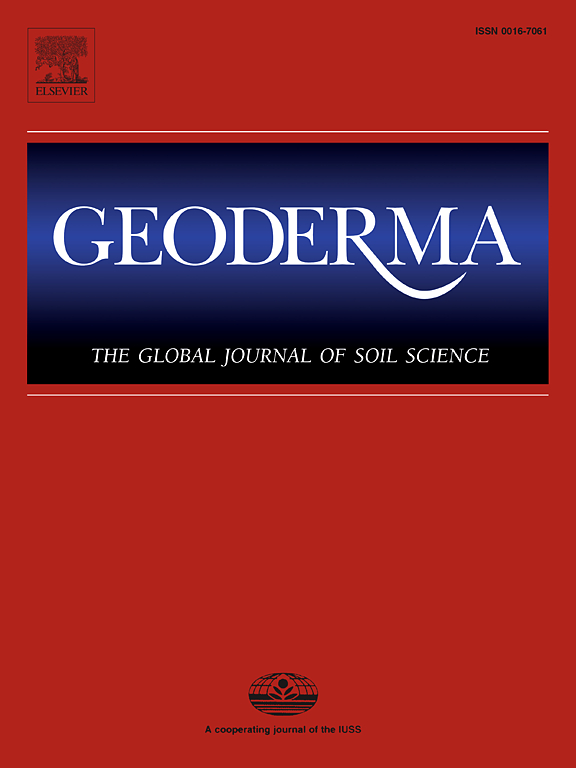Characteristic, relationship and impact of thermokarst lakes and retrogressive thaw slumps over the Qinghai-Tibetan plateau
IF 5.6
1区 农林科学
Q1 SOIL SCIENCE
引用次数: 0
Abstract
Thermokarst lakes (TLs) and retrogressive thaw slumps (RTSs) are common thermokarst landscapes that play a crucial role in regulating hydrology, ecology, and biogeochemical elements in permafrost regions. However, how TLs, as water accumulation units, affect regional water imbalances remains unclear, and whether the slow movement of shallow soil material from RTSs disrupts ecosystem barriers is still unknown. Additionally, it is uncertain whether the expansion of TLs is influenced by RTS-induced disruptions to surface water flow paths. In this study, we integrated previous research, field surveys, and remote sensing imagery to determine the evolution patterns, spatial extent, and interactions between 39,766 TLs and 1,680 RTSs on the Qinghai-Tibetan Plateau (QTP). We further employed the eXtreme gradient boosting algorithm and ICESat-2 ATL08 laser altimetry data to quantify changes in water storage due to TLs. The results revealed that TLs and RTS followed different evolutionary trajectories from 2000 to 2020. Overlapping impact areas were observed only in the headwaters of the Changjiang River, where 22 TLs and 21 RTSs co-occurred, indicating that TL formation is mainlyunaffected by RTSs. Additionally, 98% of RTS patches showed increasing NDVI trends after losing their mattic layer, demonstrating that RTSs do not impose irreversible suppression on vegetation growth. This study also comprehensively quantified how TLs contribute to regional water imbalances across regional, sub-basin, and patch scales. Summarizing and identifying the links between TLs and RTSs at a large scale can provide valuable insights into the feedback mechanisms between ecological hydrological processes and climate warming in permafrost regions, offering a reference for similar studies.

青藏高原热岩溶湖与退行性融陷的特征、关系及影响
热岩溶湖(TLs)和退行性融陷(RTSs)是多年冻土区常见的热岩溶景观,在调节水文、生态和生物地球化学要素方面发挥着重要作用。然而,tl作为水分积累单元如何影响区域水分失衡仍不清楚,来自rts的浅层土壤物质的缓慢移动是否会破坏生态系统屏障仍不清楚。此外,尚不确定TLs的扩展是否受到rts引起的地表水流动路径中断的影响。本研究综合前人研究成果、野外调查和遥感影像,对青藏高原39766个地理区域和1680个地理区域的演化格局、空间范围和相互作用进行了分析。我们进一步使用极端梯度增强算法和ICESat-2 ATL08激光测高数据来量化由于TLs导致的储水量变化。结果表明,2000 - 2020年,tl和RTS具有不同的演化轨迹。仅在长江上游出现了重叠影响区,22个TL和21个rts同时出现,说明TL的形成主要不受rts的影响。此外,98%的RTS斑块在失去基质层后呈现出NDVI增加的趋势,表明RTS对植被生长没有不可逆的抑制作用。本研究还全面量化了区域、次流域和斑块尺度上的土壤土壤对区域水失衡的影响。在大尺度上总结和识别冻土区生态水文过程与气候变暖之间的联系,可以为了解冻土区生态水文过程与气候变暖之间的反馈机制提供有价值的见解,为类似研究提供参考。
本文章由计算机程序翻译,如有差异,请以英文原文为准。
求助全文
约1分钟内获得全文
求助全文
来源期刊

Geoderma
农林科学-土壤科学
CiteScore
11.80
自引率
6.60%
发文量
597
审稿时长
58 days
期刊介绍:
Geoderma - the global journal of soil science - welcomes authors, readers and soil research from all parts of the world, encourages worldwide soil studies, and embraces all aspects of soil science and its associated pedagogy. The journal particularly welcomes interdisciplinary work focusing on dynamic soil processes and functions across space and time.
 求助内容:
求助内容: 应助结果提醒方式:
应助结果提醒方式:


